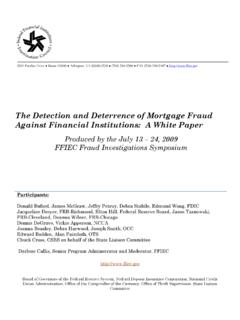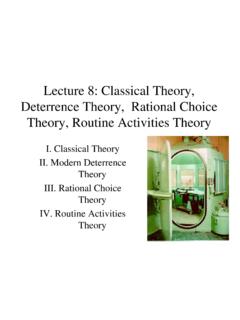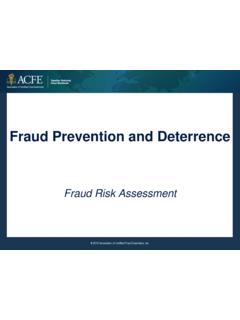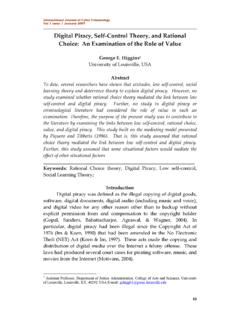Transcription of Deterrence Theory Revisited - ACRS
1 Deterrence Theory Revisited Barry Elliott1 (Presenter) 1 Consultant Psychologist Abstract Influencing discretionary driver behaviours in Australia relies very much on the coercive strategy of Deterrence . This paper stems from a thorough review of Deterrence Theory and risk taking carried out in 2002-03 for the Land Transport Safety Authority, New Zealand (Elliott, 2003). The paper begins by exploring the definition of Deterrence leading to the proposition that if motorists do not refrain from offending out of fear of consequences they are by definition not deterred. It explores the various roles Deterrence plays in influencing behaviour including its moral educative role. It argues that 'general' and 'specific' Deterrence are not different mechanisms, but the same mechanism applied to different populations.
2 The targets for 'general' Deterrence are not the general population of motorists. It is limited to the marginal group of offenders or prospective offenders who can be influenced through fear, ie are likely to offend and likely to be deterred by the threat of punishment. 1. INTRODUCTION Professor Nigel Walker (1980) Director of the UK Institute of Criminology, argued that limiting principles exist indicating when the criminal law should or should not be used, eg. - It is better to prevent than punish; -The law should not be used to penalise behaviour that does no harm; - The law should not be used to compel people to act in their own best interests.; etc. Deterrence is founded on the first mentioned principle. However, Deterrence is never the sole or primary goal of the law (legal system). 2. DEFINING Deterrence Deterrence involves the threat of punishment via some form of sanction.
3 Deterrence is a way of achieving control through fear. If motorists do not refrain from offending out of fear of consequences they are, by definition, not deterred. Deterrence , in general, is the control of behaviour that is effected because the potential offender does not consider the behaviour worth risking for fear of its consequences. Beyleveld (1979) defines the essence of Deterrence by two criteria: (15) Given X s negative attitude towards the imagined experience of undergoing what he believed were the actual penalties he risked if he committed C1., his positive motivation to commit C1, and the chance he believed existed of having what he believed were the risked penalties being inflicted upon him if he committed (or attempted to commit) C1, and the chance he believed existed of successfully fulfilling his motivation to commit C1, X decided that the personal utility of not committing C1 exceeded the personal utility of committing (or attempting to commit C1.)
4 (16) This calculation of utility was the reason why X did not commit C1. (Whatever other factors may have weighed towards X not committing C1,this calculation was necessary for X not to have committed C1, and the calculation alone or in conjunction with other factors was sufficient for X not to have committed C1). ( ) A deterrent effect of sanctions is the preventive effect of the sanction(s) resulting from the fear that the sanction(s) will be implemented. Thus Deterrence refers to any process by which the threatened act is not committed (or is at least hindered) because of the deterrent sanction. Strictly defined A person is deterred from offending by a sanction if, and only if, he refrains from that act because he fears the implementation of the sanctions, and, for no other reason.
5 (Beyleveld 1979, ) Deterrence is therefore but one compliance-gaining mechanism. 3. HOW DOES Deterrence OPERATE? The mere presence or introduction of a sanction may hinder or prevent an offence in a number of different ways: (i) Knowledge of the sanction affects perception of the cost of offending so that compliance is seen as more attractive than offending; (ii) Knowledge of the sanction, coupled with a belief in the sanctity of law or unquestioning legal authority, may be sufficient for compliance; (iii) Sanctions may also have moral-educative and habituative effects so that they may be causally involved in the generation of moral beliefs and inhibitions, and laws may be obeyed purely by force of habit; (iv) The implementation of sanctions, rather than the mere threat may, reduce offences by incapacitating potential offenders, reforming them or by creating via stigmatisation of the offender, informal pressures to comply.
6 Deterrence refers to some combinations of these different mechanisms but for strict usage (i) above must always be present or else the compliance gaining strategy is something other than Deterrence . This statement refers to the notion that people weigh up the costs and benefits in deciding not to offend and the cost is the penalties that are threatened. The philosophy underpinning Deterrence is that the risk to the law breaker must be made so great and the punishment so severe, that people believe they have more to lose than to gain from the offence. Deterrence in the literature, and in practice, is usually only in reference to a legal sanction but non-legal sanctions such as fear of ostracism or the disapproval of others are also capable of acting as deterrents as will be explored later in this Review.
7 4. THREE DIFFERENT EFFECTS Deterrence as a preventive measure has three different sorts of effects: (1) The deterrent effect -intimidation; (2) The strengthening of moral inhibitions -education; and (3) The stimulation of habitual law abiding conduct-reinforcement. Sometimes a distinction is made between primary or direct Deterrence (the intimidating effects of punishment (general and specific) and secondary or indirect Deterrence . The latter refers to the ability of formal sanctions to stimulate, reinforce and mobilise informal social disapproval and to their role in anchoring and buttressing the normative climate of the community. Salem & Bowers (1970) argue that the indirect or secondary role of Deterrence is much more substantial than the direct intimidating effects. Deterrence is thought to be less effective in controlling or eliminating habitual, unthinking behaviour.)
8 Much of driving behaviour is habitual. Fattah (1976) questions the real role of Deterrence suggesting that its primary or direct effect may hide its real effects. One would wonder whether the main function of legal sanctions with regard to drivers behaviour is intimidation (curbing or modifying the behaviour through the fear of punishment) or education (by instilling habitual modes of performance in compliance with the traffic standards and regulations)( , emphases added). 5. MISUSE OF THE TERM Deterrence Usually in the literature Deterrence is used to mean attempts to deter and the measures used are called deterrents but should be termed intended deterrents. There is a tendency, especially in the road safety literature, to refer to mechanisms that encourage compliance as being deterrents.
9 For example the Scottish Office Central Research Unit paper The Deterrent Effect of Enforcement in Road Safety refers to: Deterrence mechanisms and include (1) the driving test, (2) road safety awareness campaigns, (3) warning signs on roads and (4) explicit mechanisms which deter drivers from offending by threat of punishment (speed cameras, traffic patrols). This writer has argued (in section A6) that (1), (2) and (3) are compliance gaining techniques and are independent of a Deterrence based strategy. Deterrence ought to be more correctly used to refer to techniques that specifically set out to gain compliance by the threat of punishment. Thus, in the reference in the above mentioned paper: Other measures with potential for deterring drivers from offending the other measures are aimed at gaining voluntary compliance but not via the threat of punishment.
10 Even a dictionary definition usually includes fear in its definition of deter: To discourage or restrain (one) from acting or proceeding through fear, doubt, ie.: to frighten . When people are dissuaded from some kinds of behaviour, by being informed that they are illegal, or prohibited by rules whose legitimacy they acknowledge, it is not Deterrence . It is compliance. Any attempt to use education to eliminate misbehaviour or offending, unless it relies on fear of consequences is not Deterrence . At the heart of Deterrence is the threat of punishment. Thus barbed wire and fierce dogs are intended as deterrents provided that their presence is deliberately made obvious. Burglar proof locks are not. 6. Deterrence BEYOND FEAR Deterrence , in ordinary language usage, carries the meaning of influencing by fear.








